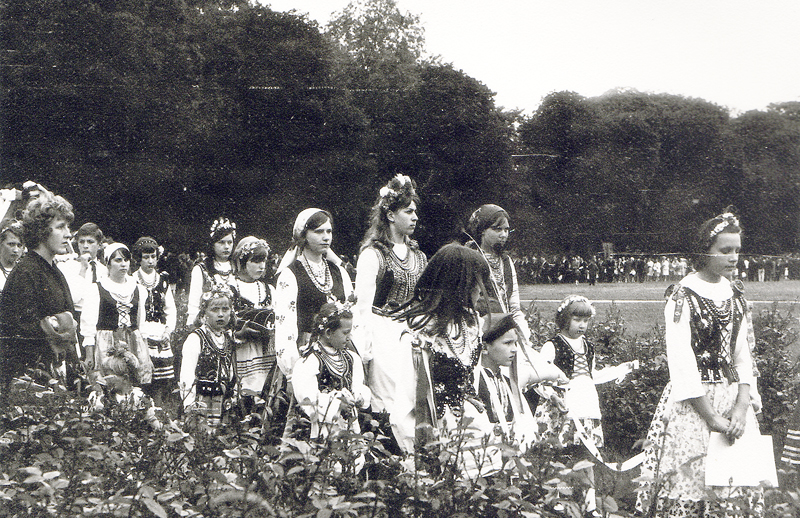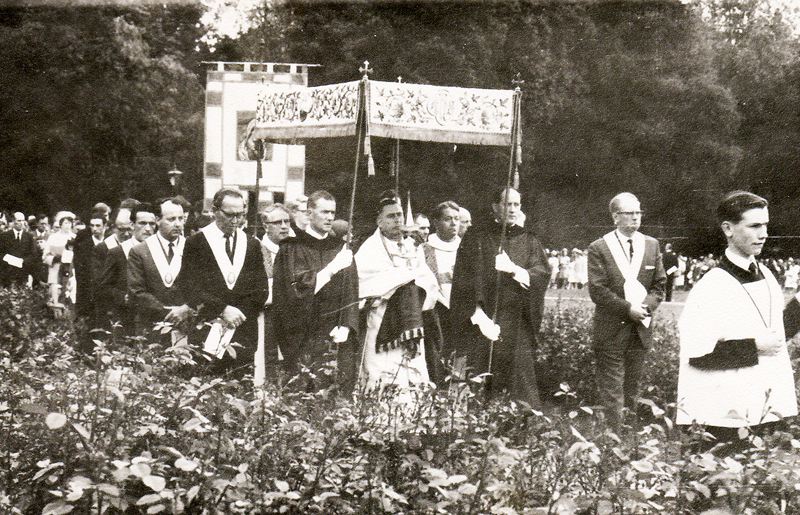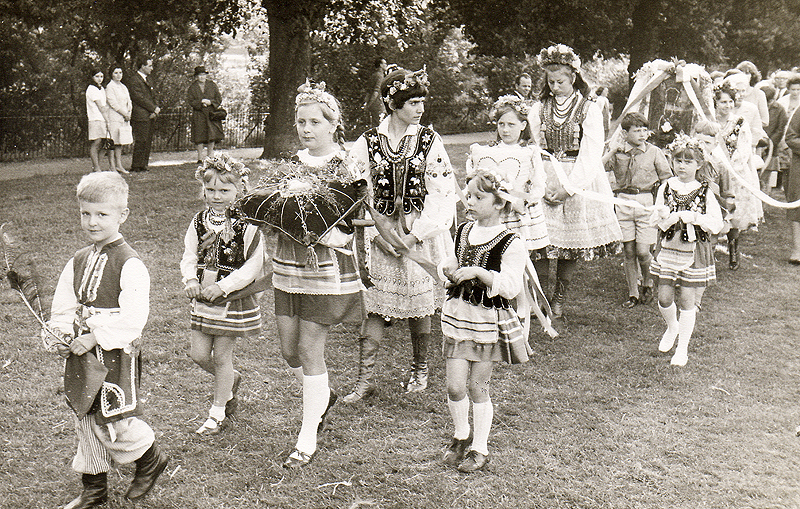1961-68
Despite efforts by individuals, until the arrival of Monsignor Jozef Golab in September 1960, the Polish community lacked an organization that could be properly inclusive. On 12th March 1961 the first AGM of the community accepted a proposal to create a central organization, and elected the first "Zarzad" (committee), chaired by Antoni Chmiel. One member of this first "Zarzad", Walerian Przeniczka, is still treasurer today. The "Zarzad" decided to call the organization "Polskie Kolo Katolickie w Leamington Spa", usually abbreviated to "Kolo". This is a reference to Poland's republican past, and the tradition of parliamentary debates being held whilst standing in a circle, thereby emphasizing the equality of all. Four main aims were formulated: education and culture (Polish Language School and library), social (celebrations and dances), religious (maintenance of the chapel) and financial (collecting annual subscriptions, initially 5 shillings per family). Unusually for a church-affiliated body, the "Kolo" was very democratic from the beginning, and all policy and other important matters were left to the AGM. The constitution is a case in point. An extraordinary AGM held on 21st May 1961, elected a Constitutional Commission to write it. This included Jan Niedziolek, Stefan Wincenty Librowski, Stanislaw Czarzasty, Sylwester Zakrzewski and Antoni Chmiel. The constitution was accepted by a majority vote at the second AGM on 18th March 1962. The creation of the "Kolo" happened at a time when the Polish community was at its most numerous. There were some 250 in Leamington Spa at the time.
 |
| Corpus Christi Procession, 1960s |
The first function organized by the "Kolo" was "Swiecone" (Easter party) combined with a dance, and was a success, since 100 people attended and a profit of 25 was made. In its first year the "Zarzad" organized a trip to London for a performance by the "Slask" dance company. There was also a visit from Miechyslaw Zielinski's Children's Theatre from Long Marston, a children's party, and the first celebration of Independence Day in Leamington Spa- a dance and a musical performance by Z. Hrynkiewiczowa. "Mikolaj" (Santa) visited the children, and an "Oplatek" (Christmas party) was organized, once again followed by a dance. Dances were for many years the preferred social activity, and were combined with every possible celebration. They also provided most of the "Kolo's" income, which was spent on a children's party and on redecorating the chapel.
The second AGM on 18th March 1962 elected a new "Zarzad" chaired by Stefan Wincenty Librowski. This "Zarzad" continued the religious and social activities, organizing the traditional celebrations and dances, but its main aims were the creation, or rather re-creation of the Polish Language School, and the purchase of a centre for the community. To this end managerial improvements were made: a Parents' Committee was set up and financed, a census was taken, financial control was improved by making an inventory of assets and giving each member a full financial statement at THE AGM, and a covenant scheme was launched.
Apathy was a major problem. Only 19 members attended the 3rd AGM on 21st April 1963, and the election of a new "Zarzad" had to be postponed for a week. Nevertheless there was considerable interest in religious activities. The Corpus Christi procession held on 24th June 1962, was the first in which the Polish community took part in an organized way. The Polish flag was followed by children carrying religious symbols and flags. The turnout was very impressive and the national costumes were much admired.
THE COVENANT SCHEME
The covenant scheme, a system of reclaiming tax on charitable contributions (now known as Gift aid) was launched on 2nd February 1964, when Stefan Wincenty Librowski, Michal Piesik, Sylwester Zakrzewski, J. Smolenski, Kazimierz Zielinski, J. Bielawski and Waclaw Swienc signed the first declarations. This was the brainchild of Stefan Wincenty Librowski, chair at the time, and was run by him until his death in 1981. It was then continued by his son dr Stanislaw Jan Librowski, and in its final 2 years by Kazimierz Librowski.
As members retired and ceased to pay tax, and also because of the increasing bureaucracy, the scheme was abandoned in 1992. By that time the scheme had contributed £19, 204.49 to the "Kolo" and 250 covenant declarations had been signed. It is worth noting that the actual number of signatories was far smaller. However, most people renewed their declarations after each 7 year term, and in a period of high inflation, frequently increased their contributions.
The first years of the covenant scheme were the most important. The figures speak for themselves. When the Polish Centre was purchased in 1968, only 20% of the purchase price had been raised. Half of that came from the covenant scheme.
Writing in the newsletter of the "Kolo" in March 1969, the then chair, Mieczyslaw Franciszek Lepkowski was very specific: Everyone should know that the 5 year old covenant scheme has provided most of the funds needed to purchase our Centre. The "Kolo" has received £922, of which £282 last year alone. This is the effect of the generosity of 53 people, who signed the covenant declaration.
PURCHASING THE POLISH CENTRE
At the second AGM of the "Kolo", held on 28th April 1963, the purchase of a centre for the community was raised for the first time, under "Any other business". On 21st July 1963 the "Zarzad" sent out a questionnaire to everyone, whose address was known, regarding this proposal. Of the 43 replies, 42 were positive, and a Polish Centre Committee was established, led by the chair of the "Kolo", Stefan Wincenty Librowski, and including Stanislaw Pierozynski ("Kolo" treasurer), Kazimierz Zielinski and Waclaw Swienc. A constitution for the proposed centre, which was to be run as a co-operative, was adopted, using that of the Halifax Centre as a model. It was hoped that £700 could be raised within a year, with the help of Polish communities in Kineton, Ladbroke Hostel, Long Marston Camp and Stratford on Avon. It was also hoped that the local authority would help. On 18th January 1964 the chair of the "Kolo" held a meeting with local councilors, about the possibility of leasing a building for a social centre and language school. He was warmly welcomed, but neither this meeting, nor any of the later ones, achieved anything positive. An added difficulty, was that although the AGM of 12th April 1964 voted in favour of purchasing a centre, the newly elected "Zarzad" showed little interest, and this undermined the efforts of the fundraisers. It didn't help that the church authorities also announced their decision to move Monsignor Jozef Golab in April 1965. It needed a petition signed by 160 Leamington Spa parishioners, and a visit to the Rektor of the Polish Catholic Mission in London by the "Zarzad", to revoke that decision. The effort required to organize the Millenium celebrations, also affected fundraising for the centre. This is why at a meeting of the "Zarzad" on 8th March 1966, the new chair, Sylwester Zakzewski again proposed leasing a building from the local authority, to establish whether the "Kolo" could successfully run a centre. Purchasing a building could happen at a future date. The Zakrzewski proposal was the focus of "Zarzad" activity in 1965-66, and it was publicized in a newsletter of the time "Biuletyn Informacyjny Polskiego Kola Katolickiego w Leamington Spa", edited by Sylwester Zakrzewski, Kazimierz Zielinski and Stefan Jankowicz. Unfortunately it proved impossible to lease a suitable building, due to a lack of understanding from the local authority, and a rather passive attitude from the Polish community. This was referred to at the AGM on 9th April 1967, when it was reported that the Centre Purchase Fund stood at £68, while the general finances of the "Kolo" stood at £1,121.
Fundraising for the purchase of a centre picked up speed after the Millenium celebrations. For the new "Zarzad" elected at the AGM on 9th April 1967, and chaired by Mieczyslaw Franciszek Lepkowski, this was an absolute priority. A sub-committee for the centre was formed, chaired by Mieczyslaw Franciszek Lepkowski, and including Prof Zbigniew Antoni Scholtz, Sylwester Zakrzewski, Stefan Kaszczyszyn and Stefan Wincenty Librowski. After inspecting a number of properties, the sub-committee proposed purchasing a now demolished regency villa on the corner of Radford Road and Forefield Place. Due to a lack of funds, it was decided to take out a loan, from either the Polish Benevolent Fund or the SPK (Polish Ex-Servicemen's Association), and a delegation made up of Prof Zbigniew Antoni Scholtz, Stefan Wincenty Librowski and his replacement Mieczyslaw Franciszek Lepkowski, was sent to London. Eventually a loan was obtained from the Polish Benevolent Fund, but difficulties arose over the purchase price. Moreover, the need for a major refurbishment made it impossible to rent out the commercial parts immediately, and that meant that rapid repayment of the loan was not feasible. This is why an extraordinary AGM held on 8th October 1967, voted against purchasing this particular property, by a majority of one. It was however felt, that further efforts had to be made. A questionnaire handed out at this AGM showed that those present were willing to pledge £733 for the purchase of a centre, which is why a new team of fund-raisers was proposed. The need for a centre was now becoming urgent, due to difficulties with the continued use of St Peter's Parish Centre, and the possibility of losing the chapel there.
Regrettably, the clear divisions, which opened up at the extraordinary AGM led to general disillusionment. The next AGM on 25th February 1968, was attended by only 20 members, and the atmosphere was subdued, despite an appeal from Monsignor Jozef Golab.
The turning point was a speech by Stanislaw Czarzasty, who criticized a lack of effort, and offered £10 for the Centre Purchase Fund. This embarrassed those present, and within a couple of minutes £125 had been collected. It was decided to elect a group of fund-raisers, including Mieczyslaw Franciszek Lepkowski, Stefan Jankowicz, S. Przedpelski, M. Siwak, Wojciech Pych, Kazimierz Zielinski and Zofia Scholtz. This group raised £372 within a month. It was reported at the AGM on 10th May 1968 that membership of the "Kolo" had increased from 29 to 67, and the number of covenant declarations had grown from 37 to 47. It was the start of a remarkable period of co-operation and unity for the Polish community.
By popular demand the AGM re-elected the management of the "Zarzad" unchanged for another term of office. There were proposals to organize social functions to improve community ties, and there were discussions about the various possible solutions for a centre. One of these was Wojciech Pych's proposal to lease a hall, formerly used by the Irish at Riverside.
The most significant date in the campaign for a centre, was an extraordinary AGM, held on 7th July 1968, when it was decided to purchase the former Town Hall and Police Station at 54, High Street. The Centre Purchase Committee had earlier obtained a loan of £8,000 at 9% interest for 15 years, outline planning permission for a club, and had prepared a business plan. Of 34 members present at the AGM, 32 approved the proposal, and authorized the Centre Purchase Committee to buy the property at auction for a maximum price of £11,000. This resolution was of course highly sensitive, and the chair, Mieczyslaw Franciszek Lepkowski appealed to the members to treat the matter as confidential, in order to keep the bidding low.
The Polish Centre was bought on 10th July 1968 for £10,000, and keys were received on 21st August 1968. On 21st July 1968 an extraordinary AGM dissolved the Centre Purchase Committee and elected a "Zarzad Domu" , also known as "Komitet Organizacyjny Domu" (Centre Management) chaired by Prof Zbigniew Antoni Scholtz, and consisting of 3 sections: admisistration (Stanislaw Czarzasty, Kazimierz Zielinski and Aldona Zakrzewska), commercial activities (Zofia Scholtz, Mieczyslaw Franciszek Lepkowski and Stefan Jankowicz), and building refurbishment (Stefan Wincenty Librowski, Sylwester Zakrzewski and Waclaw Swienc). The Centre Management began the process of adapting the building to the needs of the "Kolo", using the designs of Lipinski. It also tried to obtain a loan from one of the breweries to refinance the mortgage at more attractive interest rates, wrote a constitution, and obtained a licence for the proposed Polish Catholic Club. Internal rebuilding resulted in a new chapel, club, and bar. New central heating and electrical re-wiring was also necessary. Despite earlier offers, no brewery came forward with a loan, the excuse being the general crisis in the economy at the time. A constant difficulty facing the Centre Management was the failure of building contractors and suppliers to keep their word. After several months of activity, the Centre Management was dissolved, and all its members were incorporated into the "Zarzad" of the "Kolo".
 |
| Corpus Christi Procession 1966 |
 |
| Corpus Christi Procession 1967 |


